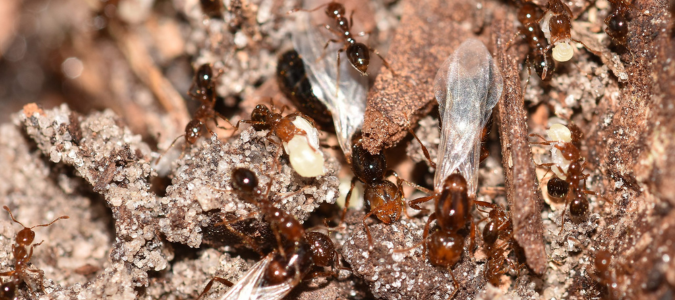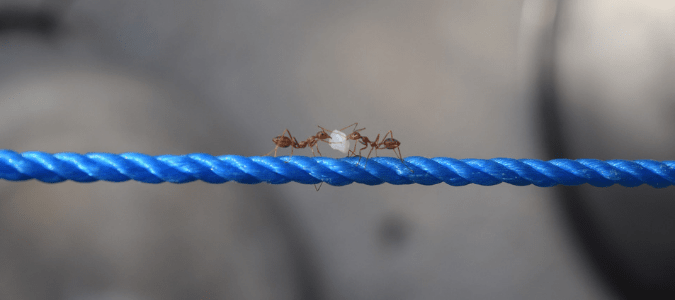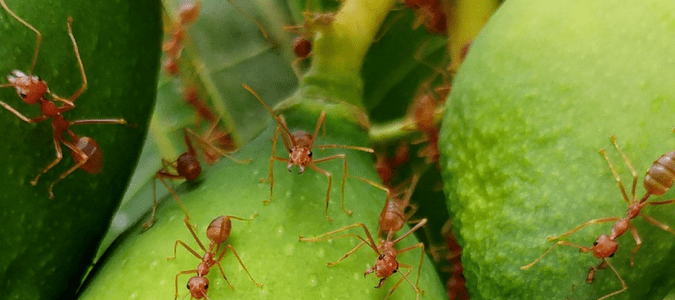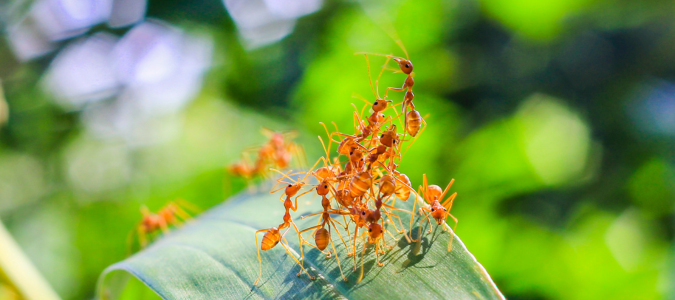Fire ants are annoying pests that can cause pain when they bite and sting. It’s important for homeowners to understand the different types of fire ants, particularly winged fire ants versus non-winged fire ants.
Fire ants with wings are the reproductive members of the colony. You may see them swarming between the spring and fall seasons when they mate. Spotting a fire ant swarm is a sign that a fire ant colony is nearby. Keep reading to learn more about how to identify fire ants with wings.
How To Identify Fire Ants With Wings
Fire ants with wings are called “reproductives” because they are the sexually mature male and female members of the ant colony that reproduce. Unlike other colony members, they have wings so they can fly away from the nest to mate and establish new colonies.
Reproductive fire ants look similar to other fire ants with the addition of wings. They have two pairs of translucent wings around the same length as their bodies. Male reproductive fire ants are slightly smaller than female reproductives and have glossier bodies with smaller heads.
When these reproductive fire ants reach maturity, they leave their nests for their “nuptial flight.” The males fly off first before the females join them to mate in the air. The males die shortly after mating, and the females shed their wings and search for a site to establish their new nest as the queen of their colony.
If you see a swarm of winged fire ants in your home or on your property, you are most likely witnessing the nuptial flight. Swarming usually takes place the morning after rainfall or on a warm and sunny day. It can happen anytime between the spring and late fall seasons.
Remember that a swarm of fire ants typically means that the original fire ant colony is nearby. If you see a swarm, do not hesitate to take action. Fire ants attack when they feel threatened, and they are known for biting and stinging humans at the same time. An encounter with a fire ant colony can cause extremely painful reactions.
Contact a pest control specialist if you see fire ants swarming near you. Do not try to eradicate the colony by yourself. An expert can take care of the problem effectively and teach you how to prevent ants in the future.
Fire Ant Caste System
Learning about the fire ant caste system can help homeowners understand fire ant behavior, which is important to deter them from entering your home. Fire ant colonies are organized into a hierarchical caste system consisting of three main castes: workers, reproductive and the queen.
Worker fire ants are sterile female ants responsible for tasks such as foraging, tending the brood and defending the nest. The winged reproductives are responsible for mating and starting new colonies.
The queen, the largest member of the colony, is responsible for laying eggs and maintaining the population. The only male fire ants are the reproductives that die after mating.
If a fire ant colony exists in your home or on your property, you will most likely notice the swarming reproductive ants first. Regardless of which caste member you come into contact with, you should contact a pest control specialist to deal with the colony.
Treating Fire Ant Bites
Fire ant bites can cause pain and discomfort, and for some people, they lead to more serious allergic reactions. Learning how to identify fire ant bites is the first step to treating them.
Fire ant bites are reddish bumps or welts that appear on the skin. You can often tell when they are fire ant bites because they are raised off the skin’s surface.
These pests typically attack humans in herds, which leaves multiple bites in one area of the body. It’s common to see a collection of fire ant bites in a line or cluster.
The most common reactions to fire ant bites are itching, stinging, pain, a burning sensation and the feeling of being pinpricked. It’s also common for the bites to turn into blisters.
To treat fire ant bites, it’s important to act quickly. First, if you are still in the area where you were bitten, move away as soon as possible to avoid further encounters with the fire ant colony. Next, gently wash the bites with mild soap and warm water. The purpose of this is to remove any dirt or debris from the bitten area; however, it’s important that you do not scrub the bites and further irritate them.
After washing, apply a cold compress to the bites for 10 to 15 minutes. Numbing the bites will relieve some of the pain and itching, and it should help the swelling go down too.
It’s important to avoid scratching the bites while they heal. Scratching will irritate the bites, cause more pain and prolong healing.
Fire ant bites are not pleasant for anyone, even if the reaction is mild. If you have fire ants in your home or around your property contact a pest control specialist to control the colony.
How to Identify Fire Ants Versus Red Ants
Fire ants, pictured above, and red ants are often mistaken for each other; however, they have key differences that can help you tell them apart. Learning to distinguish fire ants from red ants will help you identify the pests that are taking up residence in your home so that you can take the right actions to remove them.
The biggest difference between fire ants and red ants is their size. Fire ants are the smaller species, measuring around one-eighth to one-fourth of an inch long. Red ants, on the other hand, measure between one-eighth and three-eighths of an inch long.
One similarity that makes fire ants and red ants hard to tell apart is their color. They can both appear in varying shades of reddish-brown. However, some fire ants can appear black. A better way to tell them apart is by their body segments.
Fire ant bodies have two segments. Their upper body consists of their head and thorax, and their lower body consists of their abdomen. They also have distinct stingers positioned at the end of the abdomen.
Red ants, pictured above, have three body segments. Their head and their thorax are two distinct segments, and their abdomen is their third segment. They also have stingers but are not as distinct as fire ant stingers. Red ants are more recognizable for their visible mandibles that extend from their mouths.
Fire ants and red ants also behave differently, which is important for homeowners to understand. Fire ants are aggressive and known for their painful stings. They build large and often visible mounds or nests in soil with multiple entry points. Fire ants quickly swarm and attack when disturbed, causing painful bites and stings.
Red ants are also aggressive and can inflict painful bites and stings. They also construct mounds, but they are typically flatter and less noticeable. Red ants are known to be opportunistic foragers, preying on other insects, and can infest both indoor and outdoor areas.
Whether you have fire ants or red ants on your property, controlling the infestation is important. Both species can cause pain when they bite and sting. A pest control specialist can help you identify which ant is invading your property and get to work controlling them for you.
ABC Can Treat the Fire Ants on Your Property
Discovering a fire ant colony on your property is concerning for many reasons. Fortunately, ABC Home & Commercial Services can help. Our professionals will create a pest treatment plan that leaves you and your family feeling comfortable again. We can even help with other types of ants, like crazy ants.



